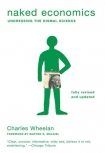Naked Economics, Wheelan, Charles [open ebook .txt] 📗

Book online «Naked Economics, Wheelan, Charles [open ebook .txt] 📗». Author Wheelan, Charles
During the depths of the “Great Recession” of 2007, however, the Fed couldn’t make money any cheaper. The Fed pushed short-term interest rates all the way down to zero, for all intents and purposes, but consumers and businesses still weren’t willing to borrow and spend (and unhealthy banks were in a poor position to lend). At that point, monetary policy can’t do anything more; it becomes like “pushing on a wet noodle,” as Keynes originally described it. This is the economic rationale for turning to a fiscal stimulus as well.
I conceded earlier in this chapter that GDP is not the only measure of economic progress. Our economy consists of hundreds of millions of people living in various states of happiness or unhappiness. Any president recovering from a horseshoe accident would demand a handful of other economic indicators, just as emergency room physicians ask for a patient’s vital signs (or at least that is what they do on Grey’s Anatomy). If you were to take the vital signs of any economy on the planet, here are the economic indicators, along with GDP, that policymakers would ask for first.
Unemployment. My mother does not have a job, but she is not unemployed. How could that be? This is not one of those strange logic riddles. The unemployment rate is the fraction of workers who would like to work but cannot find jobs. (My mother is retired and has no interest in working.) America’s unemployment rate fell below 4 percent during the peak of the boom in the 1990s; it has since climbed over 10 percent. Even that may understate the number of people out of work. When Americans without jobs give up on finding one, they no longer count as unemployed and instead become “discouraged workers.”
Anyone who cares about unemployment should care about economic growth, too. The general rule of thumb, based on research done by economist Arthur Okun and known thereafter as Okun’s law, is that GDP growth of 3 percent a year will leave the unemployment rate unchanged. Faster or slower growth will move the unemployment rate up or down by one-half a percentage point for each percentage point change in GDP. Thus, GDP growth of 4 percent would lower unemployment by half a percentage point, and GDP growth of only 2 percent would cause unemployment to rise by half a percentage point. This relationship is not an iron law; rather, it describes the relationship in America between GDP growth and unemployment over the five-decade period studied by Mr. Okun, roughly 1930 to 1980.
Poverty. Even in the best of times, a drive through Chicago’s housing projects is ample evidence that not everybody has been invited to the party. But how many Americans are poor? Indeed, what exactly constitutes “poor”? In the 1960s, the U.S. government created the poverty line as a (somewhat arbitrary) definition of the amount of income necessary to buy the basic necessities. Having been adjusted for inflation, the poverty level remains as the statistical threshold for who is poor in America and who is not. For example, the current poverty line for a single adult is $10,830; the poverty line for a family of two adults and two children is $22,050.
The poverty rate is simply the fraction of Americans whose incomes fall below the poverty line. Roughly 13 percent of Americans are poor, which is no better than we were doing in the 1970s. The poverty rate rose steadily throughout the 1980s and then drifted down in the 1990s. The overall poverty rate disguises some figures that would otherwise leap off the page: Roughly one in five American children is poor as are nearly 35 percent of black children. Our only resounding success is poverty among the elderly, which has fallen from 30 percent in the 1960s to below 10 percent, largely as the result of Social Security.
Income inequality. We care about the size of the pie; we also care about how it is sliced. Economists have a tool that collapses income inequality into a single number, the Gini index.* On this scale, a score of zero represents total equality—a state in which every worker earns exactly the same. At the other end, a score of 100 represents total inequality—a state in which all income is earned by one individual. The countries of the world can be arrayed along this continuum. In 2007, the United States had a Gini index of 45, compared to 28 for France, 23 for Sweden, and 57 for Brazil. By this measure, the United States has grown more unequal over the past several decades. America’s Gini coefficient was 36.5 in 1980 and 37.9 in 1950.
Size of government. If we are going to complain about “big government,” we ought to at least know how big that government is. One relatively simple measure of the size of government is the ratio of all government spending (local, state, and federal) to GDP. Government spending in America has historically been around 30 percent of GDP, which is low by the standards of the developed world. It’s climbing right now, both because the stimulus is driving up government spending (the numerator) and because GDP has been shrinking (the denominator). Government spending in Britain is roughly 40 percent of GDP. In Japan, it is over 45 percent; in France and Sweden it is more than 50 percent. On the other hand, America is the only developed country in which the government does not pay for the bulk of health care services. Our government is smaller, but we get less, too.
Budget deficit/surplus. The concept is simple enough; a budget deficit occurs when the government spends more than it collects in revenues and a surplus is the opposite. The more interesting question is whether either one of these things is good or





Comments (0)